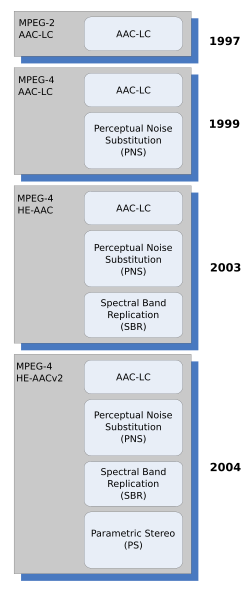| Filename extensions | MPEG/3GPP Container
Apple Container
ADTS Stream - NOT raw - Contains Headers
|
|---|---|
| Internet media type | audio/aac audio/aacp audio/3gpp audio/3gpp2 audio/mp4 |
| Developed by | ISO |
| Type of format | Audio compression format |
| Contained by | MPEG-4 Part 14, 3GP and 3G2, ISO base media file format, Audio Data Interchange Format (ADIF), Audio Data Transport Stream (ADTS) |
| Extended from | AAC |
| Standard | ISO/IEC 14496-3 |


High-Efficiency Advanced Audio Coding (HE-AAC) is an audio coding format for lossy data compression of digital audio defined as an MPEG-4 Audio profile in ISO/IEC 14496–3. It is an extension of Low Complexity AAC (AAC-LC) optimized for low-bitrate applications such as streaming audio. The usage profile HE-AAC v1 uses spectral band replication (SBR) to enhance the modified discrete cosine transform (MDCT) compression efficiency in the frequency domain.[3] The usage profile HE-AAC v2 couples SBR with Parametric Stereo (PS) to further enhance the compression efficiency of stereo signals.
HE-AAC is used in digital radio standards like HD Radio,[4] DAB+ and Digital Radio Mondiale.
- ^ ISO/IEC JTC1/SC29/WG11/N7016 (2005-01-11), Text of ISO/IEC 14496-3:2001/FPDAM 4, Audio Lossless Coding (ALS), new audio profiles and BSAC extensions, archived from the original (DOC) on 2014-05-12, retrieved 2009-10-09
{{citation}}: CS1 maint: numeric names: authors list (link) - ^ Fraunhofer IIS, MPEG-4 Audio and Video Technology (PDF), retrieved 2009-10-15[dead link]
- ^ Herre, J.; Dietz, M. (2008). "MPEG-4 high-efficiency AAC coding [Standards in a Nutshell]". IEEE Signal Processing Magazine. 25 (3): 137–142. Bibcode:2008ISPM...25..137H. doi:10.1109/MSP.2008.918684.
- ^ "Receiving NRSC-5". theori.io. 9 June 2017. Archived from the original on 20 August 2017. Retrieved 14 April 2018.